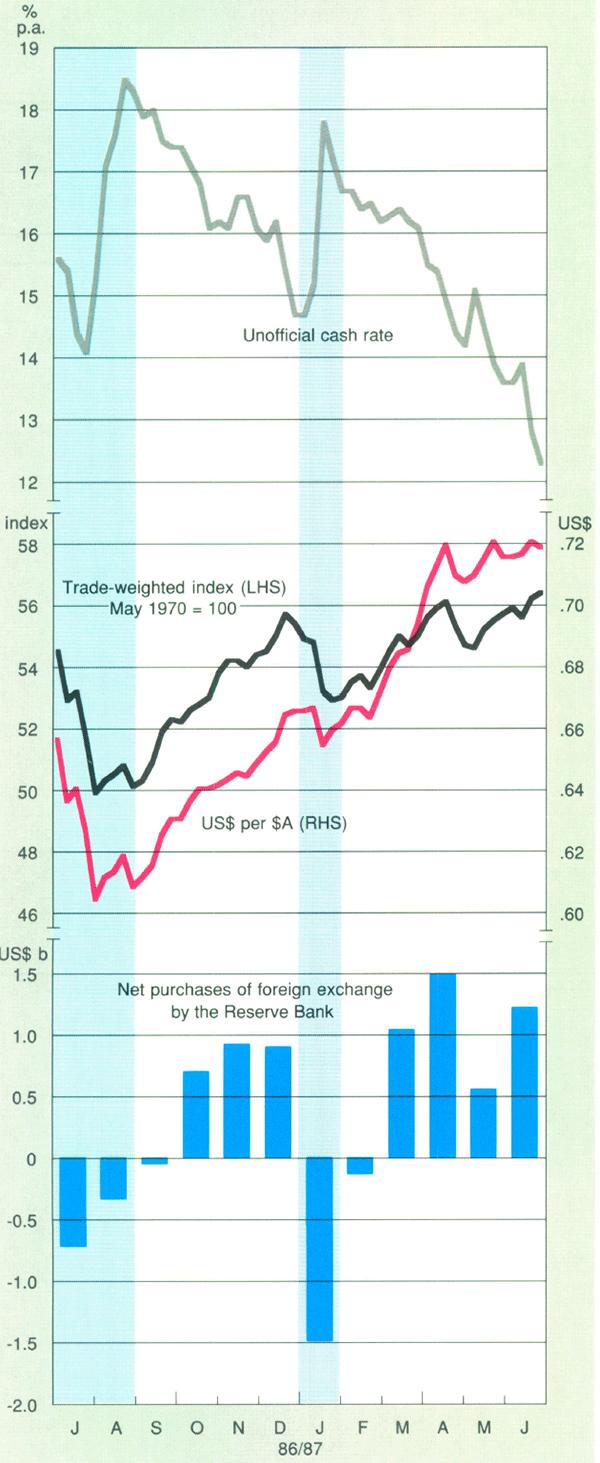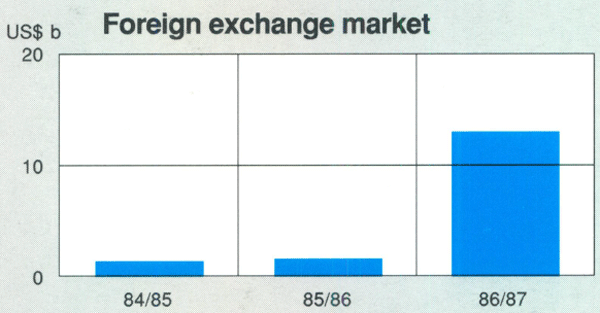Reserve Bank of Australia Annual Report – 1987 The Bank's Market Operations[1]
The Bank gives effect to monetary policy primarily by dealing in financial markets. For much of 1986/87 an immediate objective of the Bank's operations was to steady the foreign exchange market. Given the pressures which came upon the market and the rising volatility of such markets worldwide, the scale of the Bank's foreign exchange operations was relatively large. The Bank was also very active in domestic financial markets to maintain firmness in monetary conditions and to offset, as appropriate, the impact on liquidity of its foreign exchange operations.
The Bank deals in the foreign exchange markets for several purposes. In its day to day operations it seeks to enhance the efficiency of the market — by satisfying itself about the strength of emerging pressures or by smoothing the passage of larger transactions through the market. It may trade one foreign currency for another to adjust the balance of its portfolio. It also buys and sells foreign exchange to meet the requirements of clients, principally the Commonwealth Government. The Bank provides foreign currency from its holdings to meet government payments abroad as they fall due. It also purchases from the government foreign funds accruing to it, for example from overseas loan raisings. In the event, the Bank recouped all of the Government's net foreign exchange requirements in the market in 1986/87 — approximately US$1.7 billion.
In the course of providing a steadying influence, the Bank's involvement in the market can be very high at times of strong pressure. This was the most important factor in the high volume of the Bank's foreign exchange operations in 1986/87.
During the year, sentiment in the foreign exchange market went through a number of changes. This was reflected in the direction of the Bank's operations. While over the year it was a net buyer of foreign currencies, it was at times a substantial seller. One period of heavy sales occurred in July-August surrounding the 1986/87 Budget. Financial conditions were very volatile, bordering on disorderly. Over these two months, the Bank sold US$1.2 billion, purchasing in exchange the equivalent amount in Australian currency. Even so, the trade-weighted index of the exchange rate fell by 12 per cent in July to reach a low for the year of 49.3; domestic interest rates rose sharply. Markets subsequently became more orderly.
Another period of heavy involvement occurred in January at the time of the re-alignment of the currencies in the European Monetary System. Again the Australian dollar came under severe selling pressure, this time largely as a result of events outside Australia and outside its control. The Bank made sales of foreign exchange, approximately US$1.2 billion, over a few days. Domestic interest rates again rose.
At other times during the year, the Australian dollar tended to rise. During the December quarter a degree of confidence returned to the markets. In late March and April, there was a strong response to the weakening of the U.S. dollar against most currencies. Further upward pressure came from market anticipation of the measures announced in the Government's May Expenditure Statement. In June the trade-weighted index reached a high for the year of 56.6.
When the exchange rate was under strong upward pressure, the Bank reacted by purchasing substantial amounts of foreign currencies, more than recouping the reserves used at other times; domestic interest rates, for the most part, tended to decline in these periods.
4 EXCHANGE RATES, INTEREST RATES AND THE BANK'S FOREIGN EXCHANGE TRANSACTIONS

Over 1986/87, the Bank's net purchases of foreign currency in the market amounted to US$3.9 billion, compared with net sales of US$0.7 billion in 1985/86. After allowing for the US$1.7 billion of foreign currency sold to the Government, and its earnings on investment of reserves, the Bank's holdings of foreign currency rose by US$2.5 billion, net of valuation effects. The Bank's gross turnover in the foreign exchange market was US$13 billion, compared with US$1.5 billion in 1985/86. Total market turnover doubled in 1986/87.
The Bank's domestic market transactions were also heavier in 1986/87. In domestic financial markets, the Bank buys and sells government securities, either outright or under repurchase agreements. Much of this trading is to smooth fluctuations in financial conditions that would otherwise occur because of “lumpiness” in government payments and receipts, new issues of government debt or changes in public holdings of notes and coin. Also, if the Bank buys or sells foreign exchange in the market, this too affects the public's holdings of liquid assets. Initially, purchases would add cash to the system and, in the absence of other offsetting factors, the Bank would seek to absorb that through sales of government securities. Conversely, sales of foreign exchange would withdraw cash and this would be countered by Bank purchases of securities. The scale and nature of operations depends largely on the size of variations in these factors. Operations to absorb the potential liquidity effects of purchases and sales of foreign exchange were an important influence on the Bank's market operations in 1986/87. The Bank's aggregate transactions in securities totalled $50.0 billion in 1986/87 compared with $39.7 billion in 1985/86.
5 THE BANK'S TURNOVER IN FINANCIAL MARKETS


6 SECURITY YIELDS AND INTEREST RATES

If the Bank seeks to tighten monetary conditions, it sells securities beyond the cash judged to be readily available or buys less securities than is needed to offset withdrawals of cash from the system. In the normal course, money market interest rates rise and this eventually feeds through to other market yields and interest rates and ultimately to credit demand. Many other factors affect market yields, but the Bank's operations are important. In end July/early August, the Bank took the unusual step of raising sharply its Treasury note rediscount rate, even though market rates had not increased. The rediscount facility is a market “safety valve” rather than a policy instrument and the rediscount rate normally follows rather than leads market rates. On this occasion, conditions called for a quick response in the Bank's market actions, in support of its foreign exchange market operations. The unusual lift in the rediscount rate was a signal to the market which had an immediate and substantial effect. It did not indicate a permanent change in the Bank's normal approach to setting that rate.
The Bank keeps market procedures under constant review. Some technical changes were made during the year. From August 1986 authorised dealers in the short-term money market were permitted to deal with other market participants in repurchase agreements based on government securities; they have dealt in repurchase agreements with the Bank since August 1984. One result of this change was that interest rates on overnight and call funds in the official and unofficial money markets did not diverge as much in 1986/87 as previously and periods of pressure in the money markets were handled more smoothly.
Other changes extended the scope of authorised money market dealers to trade in financial futures contracts, providing greater capacity to hedge portfolios. Gearing arrangements for dealers were modified so that their maximum portfolios are now influenced by the maturity structure of securities held as well as by the level of shareholders' funds. This provides greater operating flexibility and more scope for portfolio management. Also, the maximum permissible foreign ownership of authorised dealers was raised from 25 per cent to 50 per cent.
As in other recent years, in 1986/87 new issues of government securities to the public closely matched the Commonwealth Government's deficit and maturing debt. Bond tenders were the main source of finance, there were net redemptions of Australian Savings Bonds, indexed bonds made a modest contribution and the volume of Treasury notes on issue was increased consistent with the desire to see a deeper market for these securities.
Changes in the Bank's portfolio
Changes in the Bank's balance sheet can give an indication of the forces at work in financial markets. The Bank's transactions with government and the private sector, including its foreign exchange and domestic securities operations, reflect in the size and composition of its balance sheet. Balance sheet figures are published each week.
In 1986/87, the biggest change in the Bank's balance sheet was in the item “gold and foreign exchange”. It fluctuated widely during the year, reflecting heavy purchases and sales of foreign exchange as the Bank sought to stabilise conditions in the foreign exchange market. Earnings on overseas investments and changes in the Australian dollar exchange rate were additional factors. In summary, the Australian dollar value of “gold and foreign exchange” increased over the year by $4.6 billion. The components were:
| $A billion | |
|---|---|
| • net market purchases | 5.3 |
| • net sales to Government | −2.5 |
| • earnings on investments | 0.5 |
| • valuation effects | 1.2 |
| • other | 0.1 |
About half the Bank's reserves of foreign currency are U.S. dollars, Australia's main transaction currency. The balance is held in a range of currencies, including yen and Deutschemarks; these currencies appreciated in value against the U.S. dollar over the year and, together with higher average gold prices, contributed to the rise in reserves.
The Bank's domestic monetary operations, of course, also affect the balance sheet, principally the Bank's holdings of Commonwealth Government securities. As noted above, some of these are the counterpart of its operations in the foreign exchange market. In 1986/87, the substantial fall in the Bank's holdings of Commonwealth Government securities largely mirrored the high level of the Bank's foreign exchange purchases. Other transactions of the Bank in Commonwealth securities have to do with managing the other day to day influences on cash requirements of the system. The public's holdings of notes and coin and trading banks' Statutory Reserve Deposit accounts increased by $0.8 billion and $0.2 billion respectively, during 1986/87. Deposits of the Commonwealth Government increased by $0.9 billion.
The net effect of all these factors on the Bank's holdings of Commonwealth Government securities was a decline of $2.3 billion over the year. At the end of the year, the Bank held $1.1 billion Treasury notes (down from $3.2 billion a year earlier) and $6.0 billion bonds (down from $6.4 billion).
The Bank's aggregate liabilities and assets rose by $2.0 billion over 1986/87.
Footnote
*Articles detailing the Bank's market operations in the preceding quarter are published regularly in the Bank's Bulletin. [1]